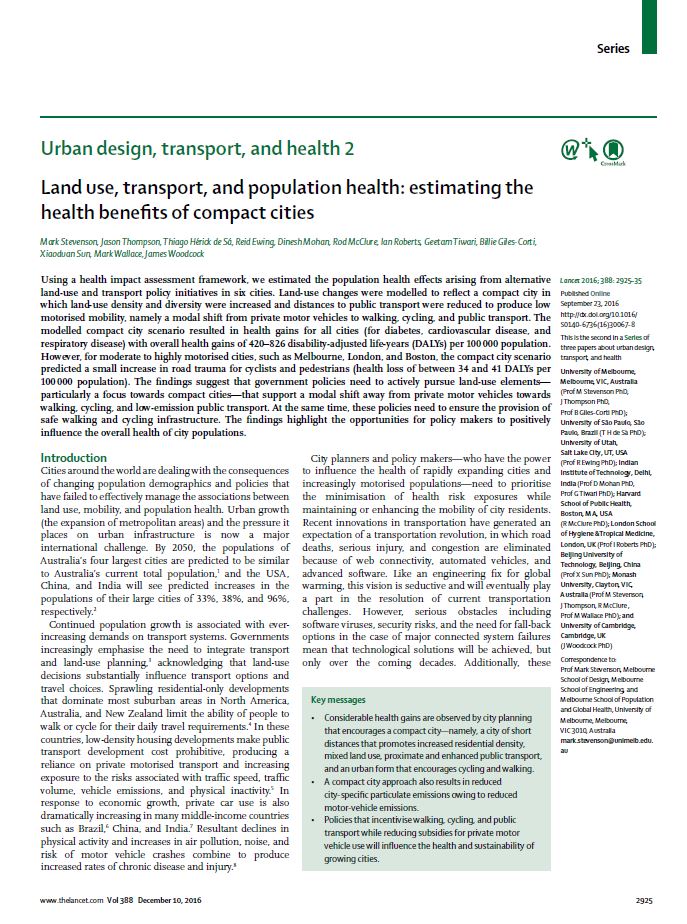Land use, transport, and population health: estimating the health benefits of compact cities
Using a health impact assessment framework, we estimated the population health effects arising from alternative land-use and transport policy initiatives in six cities.
Mark Stevenson,1 8 Jason Thompson,1 8 Thiago Hérick de Sá,2 Reid Ewing,3 Dinesh Mohan,4 Rod McClure,5 8 Ian Roberts,6 Geetam Tiwari,4 Billie Giles-Corti,1 Xiaoduan Sun,7 Mark Wallace,8 James Woodcock9
The Lancet, Vol. 388, Issue 10062
Abstract
Using a health impact assessment framework, we estimated the population health effects arising from alternative land-use and transport policy initiatives in six cities. Land-use changes were modelled to reflect a compact city in which land-use density and diversity were increased and distances to public transport were reduced to produce low motorised mobility, namely a modal shift from private motor vehicles to walking, cycling, and public transport. The modelled compact city scenario resulted in health gains for all cities (for diabetes, cardiovascular disease, and respiratory disease) with overall health gains of 420–826 disability-adjusted life-years (DALYs) per 100 000 population. However, for moderate to highly motorised cities, such as Melbourne, London, and Boston, the compact city scenario predicted a small increase in road trauma for cyclists and pedestrians (health loss of between 34 and 41 DALYs per 100 000 population). The findings suggest that government policies need to actively pursue land-use elements—particularly a focus towards compact cities—that support a modal shift away from private motor vehicles towards walking, cycling, and low-emission public transport. At the same time, these policies need to ensure the provision of safe walking and cycling infrastructure. The findings highlight the opportunities for policy makers to positively influence the overall health of city populations.
Author Affiliations
1University of Melbourne, Melbourne, VIC, Australia; 2University of São Paulo, São Paulo, Brazil; 3University of Utah, Salt Lake City, UT, USA; 4Indian Institute of Technology, Delhi, India; 5Harvard School of Public Health, Boston, MA, USA; 6London School of Hygiene and Tropical Medicine, London, UK; 7Beijing University of Technology, Beijing, China; 8Monash University, Clayton, VIC, Australia; 9University of Cambridge, Cambridge, UK
Citation
Stevenson, M., Thompson, J., de Sá, T. H., Ewing, R., Mohan, D., McClure, R., . . . Woodcock, J. (2016). Land use, transport, and population health: estimating the health benefits of compact cities. The Lancet, 388(10062), 2925-2935. doi:10.1016/S0140-6736(16)30067-8
